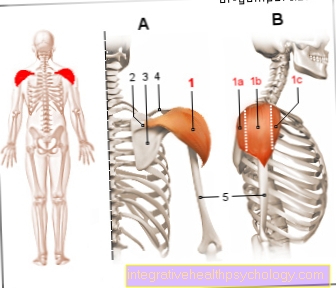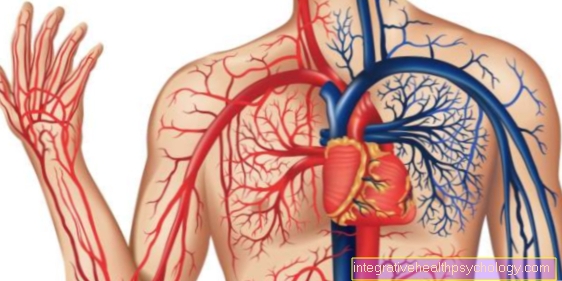Embolization

Definition - what is embolization?
Embolization is an artificial closure of blood vessels using embolizates, such as small beads made of plastic, liquids or sponges. A catheter, i.e. a long, thin wire, is pushed through an arterial access, usually in the groin, to the destination. The catheter can be followed by means of X-rays, a so-called fluoroscopy. Embolizate can then be injected into the small blood vessels using this catheter system. By closing the vessels, the blood supply to tumors, for example, can be cut off. The indications for such an operation are broad.
Indications
Embolization is a therapeutic procedure and is now a useful treatment measure for many diseases. Embolization is usually carried out by a radiologist.
It is used in neurosurgery, for example, in the treatment of vascular malformations in the head, such as an AV fistula or AV malformation. These represent so-called vascular clusters made up of several vessels. If this malformation tears, it can lead to severe bleeding in the brain. The converging arteries are closed by embolization and the AV malformation is reduced in size. These vascular malformations are not only found in the head, but also on the arms and legs and on the lungs. Embolization can also be used here.
Tumor treatment is a large area of application. The aim of embolization is to close off the vessels supplying the tumor so that the tumor is no longer supplied with nutrients and oxygen. This can prevent growth. Liver tumors, liver metastases and kidney tumors in particular are often treated with embolization, but also bone tumors of the spine or on the arms and legs.
Another clinical picture in which embolization is often used are the uterine fibroids. These are growths of the uterus, which can lead to pain and impairment due to the increase in size. Embolization can reduce growth.
Embolization is also used, albeit less frequently, in the field of emergency therapy, i.e. in the form of emergency embolization. This is used for heavy bleeding, for example in the pelvis, spleen or stomach.
Risks
Embolization is an invasive procedure and involves some risks. The patient should be informed and explained in detail about these risks by a doctor before treatment.
As with any invasive procedure, side effects can occur. Infection, pain and bleeding can occur, especially at the injection site of the vein. In addition, the introduced embolizates can bring risks, such as an allergy. In addition, some of the embolisates can get into other vessels and lead to an occlusion there. The advanced wire can also injure blood vessels and organs and cause severe bleeding.
There is a further risk of developing postembolization syndrome after treatment. Nausea, vomiting, epigastric pain, fever and flu-like symptoms occur. Medicines can improve the symptoms.
Duration
The duration of an embolization depends on the disease to be treated. In the case of easily accessible conglomerates or tumors, embolization can take about 45 to 60 minutes. In the case of very large tumors with many small vessels, however, it can last several hours. There is also a certain amount of preparation time. Any anesthesia must be initiated, the access must be punctured, etc. In general, a few hours should be planned for the procedure. A hospital stay for one or more nights may be necessary.
costs
The cost of embolization also depends on the extent of the intervention. They cannot be precisely quantified. In addition to the costs, there are material costs for the embolisms, costs for employees, the use of fluoroscopy, etc. As a rule, several 100 € come together for one procedure. If the indication is correct, however, in most cases the amount will be paid by the health insurances, both statutory and private.
What are the alternatives?
There are several alternatives to embolization, depending on the disease. However, this depends on the location of the disease or, for example, the stage of the tumor. For some vascular malformations or tumors there is a so-called "watch and wait" method. The first step is to wait to see whether the lesion enlarges over time. Until then, one should wait for treatment if the lesion does not cause the patient any discomfort.
Another alternative is surgery. Liver metastases or uterine fibroids can be removed openly or laparoscopically. In most cases, however, this represents a major operation and entails additional risks.
What is chemoembolization
Chemoembolization, also known as transarterial chemoembolization or TACE, is a method used to treat a malignant tumor. In this case, a catheter is pushed through an arterial access to the tumor under constant image control and chemotherapeutic agents are injected into the tumor area via this. Chemotherapy drugs are drugs that reduce the growth of tumors. However, they also have an impact on healthy cells, which is why they often have many side effects. The locally limited introduction of the chemotherapeutic agents into the tumor prevents the chemotherapeutic agent from reaching the healthy tissue. The closer the catheter is to the tumor area, the fewer the side effects on the entire organism. It can then achieve its effect on the tumor by flowing through the smallest arteries into the entire tumor area. In most cases, an emulsion in the form of fat particles or other embolisms is also injected into the vessels so that the vessels supplying the tumor are closed. This has an additional effect on the tumor.
Chemoembolization is often used for liver cancer or liver metastases.
also read: Therapy of liver cancer
What are coils?
Coils form platinum spirals with the help of which vessels or vascular sacs (aneurysms) can be closed. The process, which is also known as coiling, is mainly used for vascular lesions in the brain, for example aneurysms or fistulas. Similar to embolization, the coils are advanced to the destination via a wire. However, they are not yet expanded. The wire is only withdrawn at the destination and the coils can expand. You now wind up in the jar and close it.
Where can you embolize everywhere?
Embolization has many areas of application in medicine. It is most commonly used on the liver as it can often prevent surgery. Embolization is often the method of first choice for fibroids in the uterus, as well as for vascular sacs or lesions in the head. Other areas of application are diseases of the prostate and kidney.
prostate
Embolization of the prostate is often carried out as part of a benign prostate enlargement (benign prostatic hyperplasia). This is a benign tumor that enlarges the prostate and causes urination problems. Frequent urination and voiding problems are the most common symptoms. It mainly affects older patients. As a rule, attempts are made to limit the growth in size of the prostate with medication. If this treatment method is no longer sufficient, the prostate must be reduced in size interventionally. In most cases this is done surgically. Embolization, however, is a sensible alternative. Here, too, embolizates are injected into the tumor tissue via a catheter, which results in the enlarged tissue shrinking. The advantage of such an operation is that a major operation with associated anesthesia is avoided.
Find out more about the here Therapy of prostate enlargement
kidney
Embolization can also be performed on the kidney, but is only used in special cases. A distinction is made between partial or partial embolization, in which only parts of the kidney tissue are switched off, and total embolization, in which the entire kidney is embolized. In most cases, kidney embolization is only used in palliative situations. Palliative means that the disease can no longer be cured and the aim is now to relieve discomfort and pain. In the kidney, it is often the malignant renal cell carcinoma that can no longer be treated or has already metastasized several times. Embolization can help to switch off smaller areas of the tumor or to stop bleeding caused by the tumor. Sometimes embolization can also be used in preparation for surgical kidney removal.
Myoma
Myomas are benign tumors in which there is a massive enlargement of the muscle layer of organs. They are often found in the uterus, where they are called uterine fibroids. They can grow unnoticed for a long time without causing any symptoms. In some cases, however, they become so large that they press on surrounding organs or cause problems with menstruation or pregnancy inside the uterus. Then the indication for removal of the fibroid is often made. This can be done surgically or by embolization. The vessels supplying myoma can be closed by embolization and the myoma can thus shrink. This shrinkage usually takes between three to six months. Embolization is often carried out by a radiologist and in collaboration with a gynecologist. It is often a sensible alternative to surgery, as it avoids the risks of surgery and general anesthesia. It also has a very high success rate of 80-90%.
tumor
Embolization is often used in the treatment of tumors and metastases. A combination of vaso-occlusive embolization and chemoembolization is often performed. Through this combination, on the one hand, the supplying vessels are closed by means of embolisms, which leads to a reduction in the size of the tumor, and chemotherapeutic agents are injected into the tumor tissue in a targeted manner in order to kill the tumor cells. The method is particularly used in the liver, bones, kidneys and lungs.
liver
The liver is the most common organ that embolization is applied to. This can be used both as a curative measure for liver metastases or liver cancer, as well as for palliative improvement of symptoms. Tumor embolization in particular is often used in hepatocellular carcinoma (HCC). Embolization can be the sole treatment measure or serve as preparation for an operation.
You can find more information about the Liver resection.





























